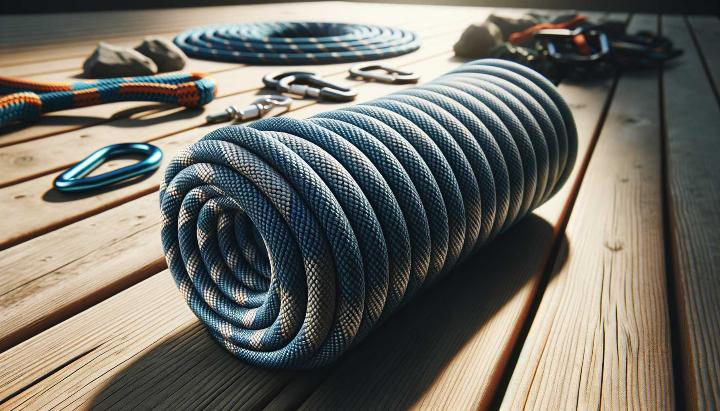Have you ever found yourself in a sticky situation where the right rope could have made all the difference? Whether you're an off-road enthusiast, a rescue professional, or simply someone who values preparedness, understanding the nuances of static cord and poly cord rope is crucial. These unassuming heroes of the rope world are far more complex than meets the eye, with their 8-strand core structures and intricate braiding techniques setting them apart from ordinary cordage.
In this exploration of static cord and poly cord rope essentials, we'll unravel the mysteries behind these versatile tools. From the polyester and nylon materials that form their backbone to the specific applications that make them indispensable, we'll cover it all. You'll discover why static recovery ropes are the go-to choice for vehicle extractions and why poly cord ropes have found their way into countless industries.
As a leading manufacturer of high-quality ropes, iRopes understands the critical role these products play in your operations. We'll guide you through the key differences between static cord and poly cord rope, helping you make informed decisions for your specific needs. Whether you're looking for customised solutions or off-the-shelf excellence, this deep dive into rope essentials will equip you with the knowledge to elevate your projects and ensure safety in even the most challenging environments.
So, tighten your grip and prepare to be enlightened – the world of static cord and poly cord rope is about to unfold before your eyes!
Understanding the Composition of Static Cord
When it comes to outdoor adventures and safety-critical applications, understanding the composition of static cord is crucial. As an avid climber and rescue equipment enthusiast, I've come to appreciate the intricate design that makes these ropes so reliable. Let's dive into the fascinating world of static cord construction and discover what makes them tick.
Materials Used in Static Rope Construction
Static cords are primarily crafted from synthetic fibres, each chosen for its unique properties. The most common materials include:
- Polyamide (Nylon): Known for its excellent strength-to-weight ratio and ability to absorb energy.
- Polyester: Offers superior UV resistance and maintains its strength when wet.
- Polypropylene: Lightweight and water-resistant, ideal for water rescue scenarios.
These materials work together to create a rope that's not only strong but also durable in various environmental conditions. Have you ever wondered why static ropes feel so different from dynamic climbing ropes? It's all in the composition and construction.
Kernmantle Structure of Static Cords
The secret to a static cord's performance lies in its kernmantle construction. This ingenious design consists of two main parts:
- The core (kern): This is the heart of the rope, typically made up of parallel fibre bundles that run the length of the cord. It's responsible for bearing the majority of the load.
- The sheath (mantle): A tightly braided outer layer that protects the core from abrasion and UV damage while adding to the overall strength of the rope.

This kernmantle structure is what gives static cords their characteristic low elongation - typically less than 5% under load. It's a far cry from the dynamic ropes I use for lead climbing, which can stretch up to 30% to absorb fall energy.
The low-stretch property of static cords makes them ideal for applications where minimal movement is crucial, such as rappelling, rescue work, and setting up fixed lines. Have you ever tried to ascend a rope that stretches with every pull? It's exhausting! That's why static cords are the go-to choice for many vertical work scenarios.
Did you know? The 8-strand core structure commonly used in static cords enhances strength and durability, while the braided sheath provides a compact and smooth surface for easy handling and reduced wear.
Understanding the composition of static cord is more than just technical knowledge - it's about appreciating the engineering that keeps us safe in challenging environments. Next time you handle a static cord, take a moment to feel the smooth surface and think about the complex structure beneath. It's a testament to human ingenuity and our quest for safer adventures in the great outdoors.
Exploring the Versatility of Poly Cord Rope
As someone who's spent years working with various types of ropes, I can't help but marvel at the incredible versatility of poly cord rope. It's like the Swiss Army knife of the rope world - adaptable, reliable, and always up for a challenge. Let's dive into what makes this synthetic wonder so special.
Applications and Advantages of Polypropylene Rope
Poly cord rope, also known as polypropylene rope, has found its way into countless industries and applications. From marine environments to construction sites, this lightweight champion punches well above its weight class. Here's why it's become a go-to choice for so many:
- Water-resistant wonder: Unlike natural fibres, polypropylene doesn't absorb water, making it perfect for marine use. I've seen these ropes perform brilliantly on boats, barely gaining an ounce even after hours in the water.
- Lightweight yet strong: Don't let its feather-light feel fool you. Poly cord rope boasts an impressive strength-to-weight ratio, making it easy to handle without compromising on load capacity.
- UV-resistant and durable: Whether it's scorching sun or freezing conditions, poly cord rope holds its own. I've left some out in my backyard for months, and it still looked and performed like new.
- Cost-effective solution: For budget-conscious projects, poly cord rope offers excellent value without skimping on quality.

Comparing Poly Cord to Other Synthetic Ropes
While poly cord rope shines in many areas, it's important to understand how it stacks up against other synthetic options like nylon and polyester. Here's a quick comparison to help you choose the right rope for your needs:
| Property | Poly Cord (Polypropylene) | Nylon | Polyester |
|---|---|---|---|
| Strength | Good | Excellent | Very Good |
| Water Resistance | Excellent | Poor | Good |
| UV Resistance | Good | Poor | Excellent |
| Elasticity | Low | High | Medium |
| Cost | Low | High | Medium |
As you can see, each rope type has its strengths. For instance, while nylon might be your best bet for applications requiring high strength and elasticity, poly cord rope excels in water-based scenarios and offers great value for money. Learn more about poly cord applications in various industries to understand its versatility.
Pro Tip: When choosing between synthetic rope types, always consider the specific demands of your project. Factors like load requirements, exposure to elements, and frequency of use should guide your decision.
Have you ever used poly cord rope in your projects? I'd love to hear about your experiences in the comments below. And remember, whether you're rigging a sailboat or securing a load on a truck, the versatility of poly cord rope might just make it your new go-to solution.
Applications and Uses of Static Recovery Rope
As an off-road enthusiast and recovery specialist, I've come to appreciate the unique qualities of static recovery ropes. These unsung heroes of the 4x4 world offer a level of control and precision that's hard to match. Let's dive into the world of static recovery ropes and explore why they're becoming increasingly popular among seasoned off-roaders.
Vehicle Recovery: Static vs Dynamic Techniques
When you're stuck in the mud or sand, the type of recovery rope you use can make all the difference. Static recovery ropes, unlike their dynamic counterparts, offer minimal stretch - typically less than 3%. This characteristic makes them ideal for controlled, steady pulls.
- Consistent tension: Static ropes maintain a steady load, preventing the jerking motion associated with kinetic ropes.
- Precise control: The lack of stretch allows for more accurate positioning during recovery operations.
- Reduced risk of recoil: In case of a break, static ropes are less likely to snap back violently.
I remember a particularly tricky recovery in the Victorian High Country. We were extracting a bogged 4x4 from a steep incline, and the static rope's consistent pull was crucial in preventing the vehicle from sliding sideways. It's moments like these that really showcase the value of static recovery techniques. For tailored solutions, you might consider reviewing optimal rope choices for your next adventure.

Rescue Operations and Safety Applications
Beyond vehicle recovery, static ropes play a crucial role in various rescue scenarios. Their high breaking strength and minimal stretch make them indispensable in situations where lives are on the line.
- Fire rescue: Firefighters rely on static ropes for rappelling and victim extraction in high-rise emergencies.
- Swift water rescue: The rope's ability to maintain position against strong currents is vital in water-based rescues.
- Industrial safety: Static ropes are often used in fall arrest systems and for securing heavy equipment.
Have you ever considered how different these scenarios would be with a bouncy, stretchy rope? The thought alone makes me shudder. The stability of static ropes provides rescuers with the confidence they need to focus on the task at hand, rather than worrying about equipment reliability.
Towing and Controlled Pulling Scenarios
When it comes to towing and controlled pulling, static recovery ropes shine. Their minimal stretch properties allow for precise manoeuvring, which is crucial in tight spaces or when dealing with heavy loads.
- Heavy vehicle towing: The consistent tension helps prevent sudden jerks that could damage vehicle components.
- Equipment positioning: In construction and industrial settings, static ropes offer the control needed for precise placement of machinery.
- Cargo securement: The rope's low elasticity ensures loads remain stable during transport.
I once used a static rope to help position a large generator in a remote campsite. The ability to make small, controlled adjustments was invaluable in getting the heavy equipment exactly where it needed to be without risking damage or injury.
Safety first! Always inspect your static recovery rope before use and never exceed its rated breaking strength. Remember, a rope's condition can deteriorate over time, especially if exposed to harsh elements or chemicals.
Whether you're an off-road enthusiast, a rescue professional, or someone who occasionally needs to move heavy loads, understanding the applications of static recovery ropes can be a game-changer. Their versatility, strength, and controlled performance make them an essential tool in any serious recovery kit. Next time you're faced with a challenging pull or rescue scenario, consider reaching for a static rope - you might be surprised at how much easier it makes the job.
Choosing the Right Static Cord or Poly Cord Rope
When it comes to selecting the perfect rope for your needs, the choice between static cord and poly cord rope can make all the difference. As someone who's spent countless hours rigging, hauling, and climbing, I've learned that the right rope can be a lifesaver - quite literally in some cases. Let's dive into the world of rope selection and unravel the mysteries of static and dynamic ropes.
Comparing Nylon and Polyester Ropes
The battle between nylon and polyester ropes is as old as synthetic fibres themselves. Each has its strengths, and understanding these can help you make an informed decision:
- Nylon's elastic advantage: Nylon ropes stretch more, absorbing energy like a champ. I've seen this in action during rock climbing, where that extra give can mean the difference between a soft catch and a jarring stop.
- Polyester's steadfast nature: On the flip side, polyester ropes offer superior UV resistance and maintain their strength when wet. For long-term outdoor use, polyester is often my go-to choice.
Remember, the best rope for you depends on your specific needs. Are you setting up a zipline that requires minimal stretch? Polyester might be your best bet. Planning a climbing expedition? Nylon's energy-absorbing properties could be crucial.
Applications for Static and Dynamic Ropes
Understanding the difference between static and dynamic ropes is crucial for safety and efficiency. Let's break it down:
- Static ropes: These are your workhorses for rescue operations, caving, and hauling loads. With minimal stretch, they provide the stability needed for controlled descents and ascents.
- Dynamic ropes: These are the unsung heroes of the climbing world, designed to stretch and absorb the energy of a fall. They're your best friend when lead climbing or setting up top-rope systems.
I once made the mistake of using a static rope for lead climbing - let's just say the experience was eye-opening and not in a good way. The lack of stretch meant every fall was more jarring than it should have been. Learn from my mistake: always match your rope type to your activity!

When choosing between static and dynamic ropes, consider your primary use case:
- Opt for static ropes when: You need minimal stretch for activities like rappelling, rescue work, or setting up fixed lines.
- Go for dynamic ropes when: You're engaging in activities where falls are possible, such as rock climbing or mountaineering.
Remember, the diameter, strength, and elongation of your rope are crucial factors to consider. A thicker rope might offer more durability, but it also means more weight to carry. It's all about finding that sweet spot between strength and practicality.
Pro Tip: Always check the manufacturer's specifications for breaking strength and recommended uses. Your safety depends on using the right tool for the job!
Choosing the right rope isn't just about technical specifications - it's about understanding your needs and the demands of your activity. Whether you're scaling cliffs, setting up a rescue system, or just need a reliable cord for your next camping trip, taking the time to select the right rope will pay dividends in safety and performance.
Have you had any experiences where choosing the right (or wrong) rope made a big difference? Share your stories in the comments below - your insights could help fellow adventurers make better choices in their rope selection journey!
Understanding the essentials of static cord and poly cord rope is foundational for selecting the right tool for your needs. Static cord ropes, often crafted from polyester and nylon, boast an 8-strand core structure that enhances strength and durability while maintaining low stretch—a perfect fit for stationary applications. On the other hand, poly cord rope, a lightweight yet robust option, excels in versatility with its high tensile strength and impressive resistance to abrasion and UV damage, making it a cost-effective choice across various uses. Whether you're considering applications for a static recovery rope or simply choosing between options, factors like material composition and load capacity are crucial to ensure optimal performance.
Connect with Us for Your Rope Needs
Above, you'll find our inquiry form – a direct line to personalised rope solutions tailored to your unique requirements. Whether it's static cord or poly cord rope, our team at iRopes is here to guide you in making an informed decision. Reach out today and elevate your projects with the perfect rope choice!